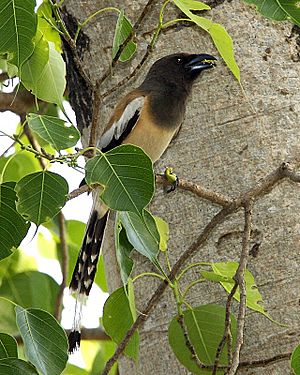Rufous treepie facts for kids
Quick facts for kids Rufous treepie |
|
|---|---|
 |
|
| Conservation status | |
| Scientific classification | |
| Kingdom: | |
| Class: | |
| Order: | |
| Family: | |
| Genus: |
Dendrocitta
|
| Binomial name | |
| Dendrocitta vagabunda |
|
The rufous treepie (Dendrocitta vagabunda) is a species of bird in the Corvidae (crow) family. The rufous treepie is native to the Indian Subcontinent and adjoining parts of Southeast Asia from Pakistan to Vietnam. Woodland, forest edges and gardens are the habitat of this species. It feeds on various fruits, insects and carrion.
Distribution and subspecies
The rufous treepie builds its nest 6−8 meters above the ground in trees. Both male and female take turns breeding and feeding the young. There are usually 3-5 eggs laid. After the young have hatched, the remain with their parents for several months. Rufous treepies form pair bonds for life.
The species was first described in 1790 by John Latham. A previous description as "Dendrocitta rufa" is not valid. It belongs to the Treepie genus Dendrocitta which is Southeast Asian in distribution. According to ornithologist Derek Goodwin, the rufous treepie may be closely allied to the hooded treepie (D. frontalis). There are eight recognized subspecies. There are no estimates for the population of this species. It is common throughout its range, but rare in Vietnam.
Description
The Rufous Treepie is shorter and smaller than the European magpie. The head, neck and breast are grey, although sometimes they are slightly brown. The underparts and lower back are orange-brown. The tail is a light blue color with a black tip. The bill, legs and feet are black.
See also
 In Spanish: Urraca vagabunda para niños
In Spanish: Urraca vagabunda para niños



